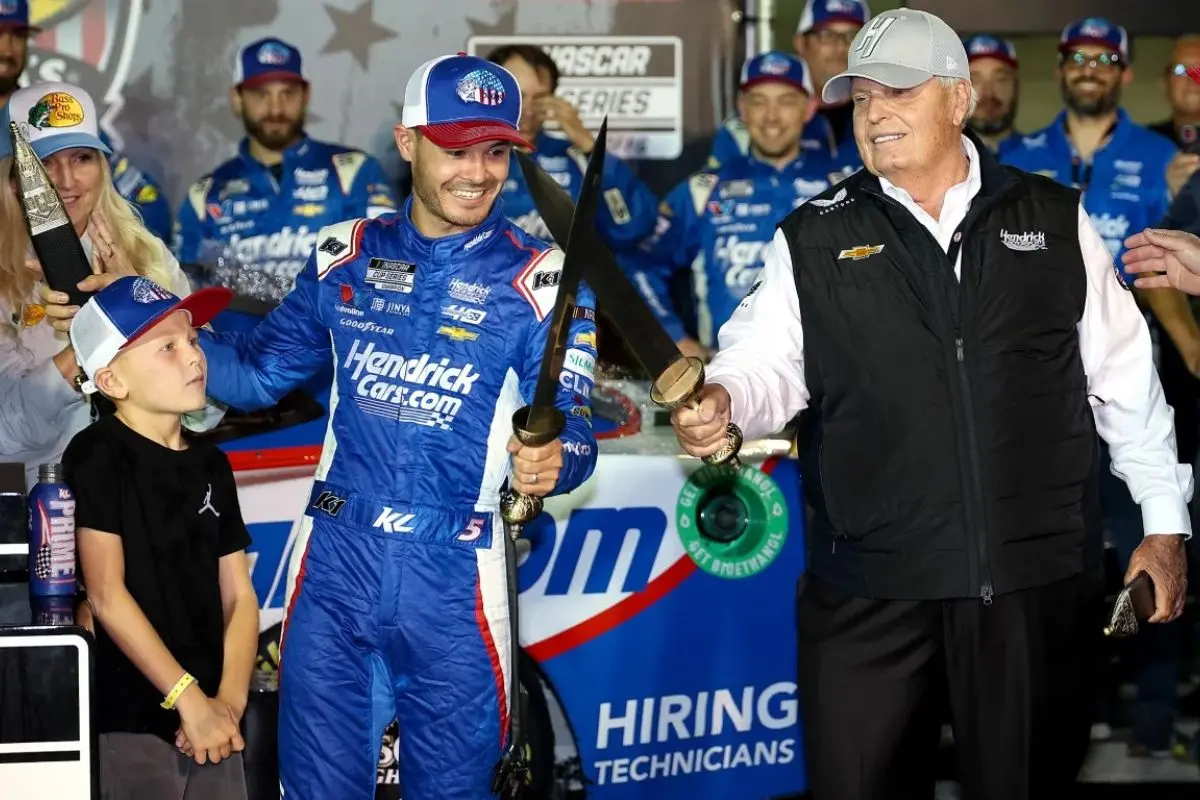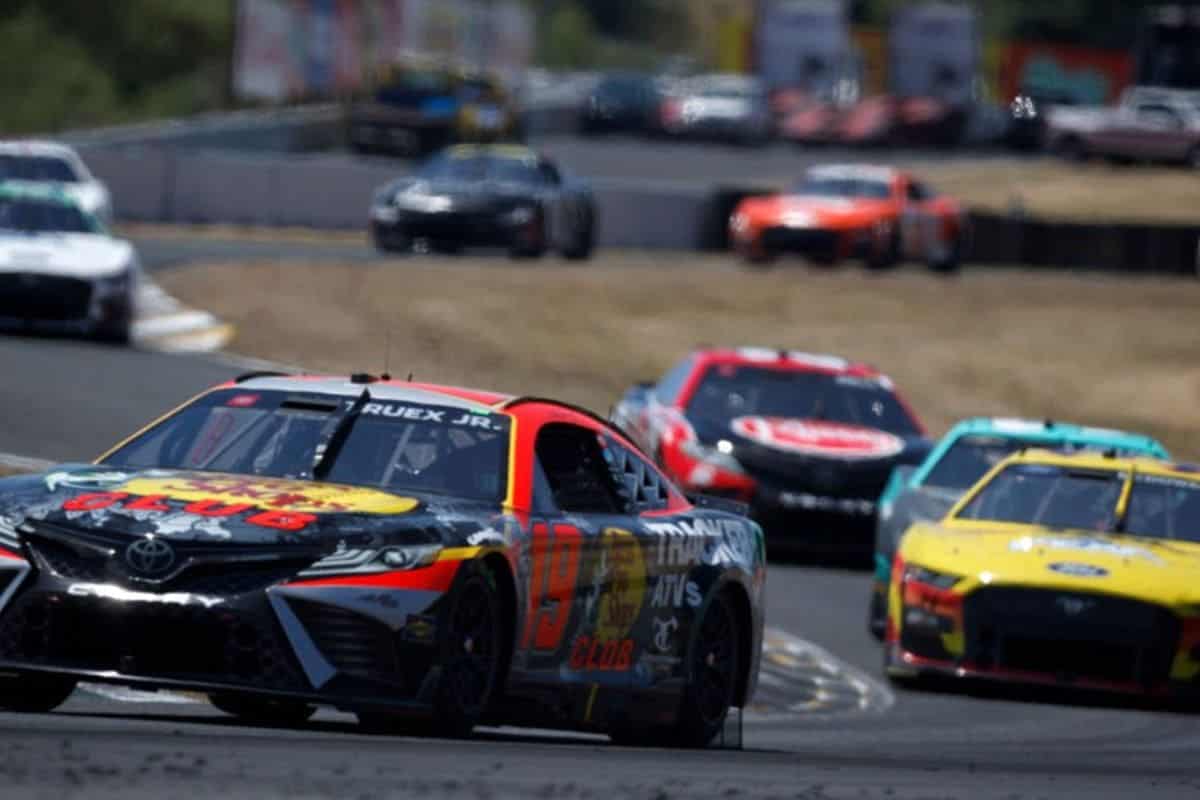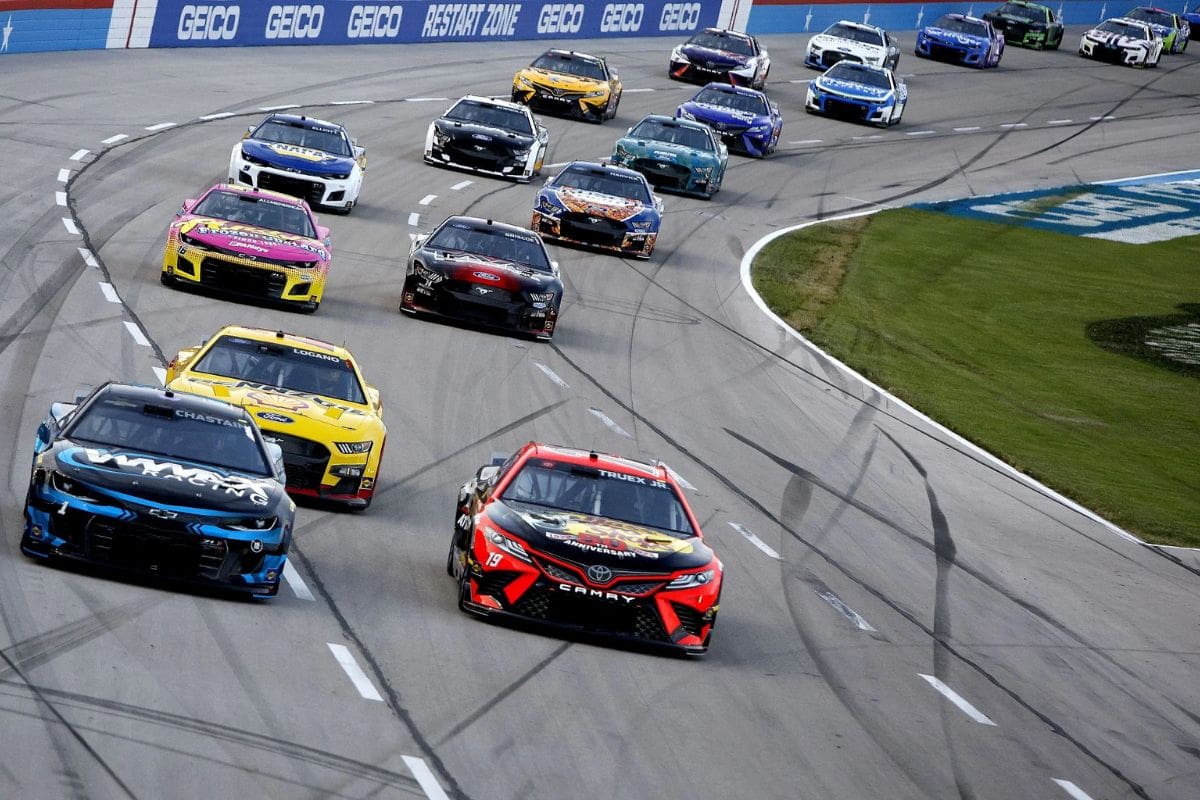Kyle Larson’s Historic Performance at Bristol: Kyle Larson‘s commanding victory at Bristol, where he led an amazing 462 laps, has restored discussions surrounding the efficacy of the Next-Gen car in fostering competitive racing. While Larson’s skills were on full display, the limited number of race leaders—only four throughout the event—has drawn criticism from fans who felt the race lacked the anticipated excitement. This raises crucial questions about the car’s design and its impact on short-track dynamics, driving calls for potential modifications. What changes might be necessary to restore the thrill of short-track racing, and how might they affect the future of NASCAR?
Key Highlights
- Kyle Larson dominated the Bristol race, leading 462 of 500 laps, showcasing the No. 5 Chevrolet’s capabilities and his driving skills.
- Fans criticized the Next-Gen car for its handling and speed, leading to concerns about competitive balance in NASCAR.
- Only four drivers led the race, tying for the fewest lap leaders in a Next-Gen event, raising questions about race excitement.
- Insiders defended the Next-Gen car’s performance, noting similar challenges faced by previous NASCAR generations and emphasizing the sport’s long-term viability.
- Samantha Busch expressed frustration with the race’s lack of excitement, calling for significant changes to the Next-Gen car design.
Dominance of Kyle Larson at Bristol
How does one define true dominance in NASCAR? In the domain of motorsport, dominance can be quantified through a driver’s ability to control a race, evidenced by leading a considerable majority of laps and establishing a palpable gap between themselves and the competition.
Kyle Larson’s performance at Bristol Motor Speedway serves as a prime example of this phenomenon. Leading an astounding 462 of 500 laps, Larson not only demonstrated his driving skill but also highlighted the capabilities of the No. 5 Chevrolet under the NASCAR Next-Gen car framework.
This commanding display of speed and skill reflects Larson’s mastery of short track racing, a discipline that demands precision, patience, and an acute understanding of tire degradation and track positioning. His ability to maintain an almost insurmountable lead throughout the event is indicative of both his individual talent and the effectiveness of his team’s strategies.
However, it also raises questions about the competitive balance within the NASCAR circuit, particularly concerning the Next-Gen car’s performance on short tracks.
While Larson’s achievement is commendable, it is crucial to contextualize this dominance within ongoing discussions about the entertainment value of races on shorter circuits. Fans have expressed concerns regarding the lack of overtaking opportunities and general excitement under the current car specifications.
Criticism of the Next-Gen Car
Amid ongoing debates surrounding the Next-Gen car, criticisms have emerged regarding its impact on the competitive dynamics of NASCAR. The recent race at Bristol, where Kyle Larson‘s commanding performance led him to dominate for 462 laps, has reignited discussions about whether this new vehicle model detracts from the excitement and unpredictability that fans cherish.
Critics have pointed to the alarming statistic of only four drivers leading the race, tying it for the fewest lap leaders in a Next-Gen event, as evidence that the car’s design may be stifling competition.
Social media has become a hotbed for discontent, with voices like Samantha Busch expressing frustration over the perceived decline in race quality, blaming the Next-Gen car for a lack of overtakes and thrilling finishes. This sentiment resonates with some fans who fear that the current format might jeopardize the sport’s competitive nature.
A notable comment on social media even claimed.
“This car is going to be the death of NA$CAR!!!” – (FAN REACTION)
However, it is crucial to approach these criticisms with a critical lens. While there is merit to the concerns raised, insiders within the sport have countered these claims with statistical evidence suggesting that the Next-Gen car has not fundamentally altered the competitive landscape.
As NASCAR navigates these evolving dynamics, the dialogue surrounding the Next-Gen vehicle will likely persist, highlighting the balance between innovation and tradition in motorsport.
Insider Response to Fan Concerns
Insider responses to fan concerns regarding the Next-Gen car reveal a sophisticated perspective that challenges the prevailing criticism. The associate editor for Kickin’ the Tires, Eggert, points out that the apprehensions surrounding the Next-Gen car may be somewhat overstated. He argues that the historical context of NASCAR races suggests that fluctuations in leader counts are not a new phenomenon, even with the sport’s previous models.
891 @NASCAR Cup races have had 4 or few leaders. Only 3 of which have been with the #NASCAR #NextGen car. I think the sport will be just fine long term.#BassProNightRace | #NASCARPlayoffs https://t.co/W9P8osja8q
— Seth Eggert (@SethEggert91) September 22, 2024
“891 @NASCAR Cup races have had 4 or few leaders. Only 3 of which have been with the #NASCAR #NextGen car. I think the sport will be just fine long term.”-(EGGERT)
To better understand this viewpoint, consider the following insights:
- Historical Data: Of the 891 NASCAR Cup races, only four featured four or fewer leaders, with three of these occurring under the Next-Gen car’s tenure. This statistic highlights that such occurrences are not exclusive to the latest model.
- Comparative Analysis: The performance issues attributed to the Next-Gen car, particularly on short tracks and road courses, mirror challenges faced by previous generations, which are often romanticized in fan memory.
- Long-Term Viability: Eggert expresses confidence in the sport’s long-term health, suggesting that initial growing pains are part of any shift, especially one as notable as the introduction of a new car model.
- Nostalgia vs. Reality: Acknowledging the emotional ties fans have to past vehicles, it is crucial to assess criticisms through a lens of empirical evidence rather than sentiment alone.
Samantha Busch’s Frustration
Frequently voicing her opinions on social media, Samantha Busch expressed her discontent with the performance of the Next-Gen car during the recent race at Bristol Motor Speedway. Her frank remarks highlighted a growing sentiment among fans and participants regarding the current state of short-track racing.
In her post, she emphasized, “Not just saying this bc we didn’t run well but can we all agree the only exciting part of the race was watching Owen celebrate w Kyle.” This statement accentuates the noticeable contrast between Larson’s celebratory moment and the general lack of excitement throughout the event.
“Not just saying this bc we didn’t run well but can we all agree the only exciting part of the race was watching Owen celebrate w Kyle. Can’t remember a Bristol race being that blah in long time. Time to cancel this race car.”-(SAMANTHA BUSCH)
Busch’s assertion about the race being “blah” resonates deeply, as it reflects a broader concern regarding the entertainment value of races conducted with the Next-Gen vehicles. The apparent absence of competitive action, particularly at a venue renowned for its thrilling atmosphere, raises questions about the car’s design and its impact on racing dynamics.
Her suggestion to “cancel this race car” signals frustration not just with her husband’s performance but with the implications of this new technology on the sport’s excitement and engagement levels.
Need for Improvements in Short-Track Racing
Short-track racing, a cornerstone of NASCAR’s appeal, has come under scrutiny following recent events at Bristol Motor Speedway, highlighting an urgent need for advancements in the sport’s competitive package. The disparity in racing quality between events raises crucial questions regarding tire performance and vehicle design, particularly with the Next-Gen car.
Despite attempts to improve the racing experience through softer tire compounds and aerodynamic adjustments, the lack of effective solutions remains evident.
“Perhaps tires that last 300 laps are a bigger issue than the car. Perhaps it’s time to cancel Goodyear. Or nascar as a whole.”
“Drivers say the car needs more horsepower to increase off-throttle time and not act as if they are just riding a rail. Why isn’t nascar realizing horsepower could fix a lot of their issues. Bigger tires plus less horsepower equals tonight.”
“Running the Xfinity cars at short tracks is the obvious solution. NASCAR could easily spin it as being a huge positive for the fans back to our roots of short-track racing. It would be a PR victory in the end. The cost to teams would be offset by needing less NG cars.” -(FANS REACTON)
To address the shortcomings observed during the 2024 Bass Pro Shops Night Race, NASCAR must consider targeted improvements in the following areas:
- Tire Composition: Revisiting tire materials and designs to guarantee proper falloff that promotes competitive passing and tactical pit stops.
- Aerodynamic Adjustments: Further refining the Next-Gen car’s splitter and diffuser configurations to boost downforce without sacrificing parity among competitors.
- Race Format Reevaluation: Implementing changes to the race format that encourage more aggressive driving and overtaking, potentially through staged cautions or varying pit strategies.
- Fan Engagement Initiatives: Creating platforms for fan feedback and suggestions to assure that improvements align with community expectations and elevate the complete viewing experience.
“Cancel all short tracks and road courses, turn everything into a cookie-cutter mile and a half. One thing I will say is do not put racing product in Good Years hands. That’s not their job and they’re going to protect their “image”. Fix the damn car.”-(FANs’ REACTION)
The recent Bristol race highlighted that simply attributing the challenges to the Next-Gen car or tire manufacturer Goodyear is insufficient.
A thorough, multifaceted approach is vital to rejuvenate short-track racing, guaranteeing it remains a thrilling and integral part of NASCAR’s identity.
News in Brief: Kyle Larson’s Historic Performance at Bristol
ALSO READ: Kyle Larson’s Late-Night Meet and Greet: Fans Call Him “A Modern Day Richard Petty”



